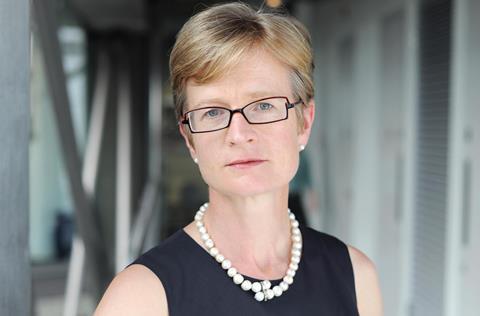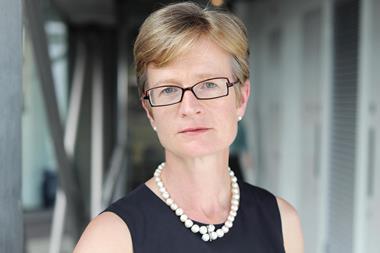Big changes are on the horizon for Marks & Spencer’s multichannel business. Laura Heywood talks to ecommerce boss Laura Wade-Gery about how she’s making the web the retailer’s flagship store.

When Marks & Spencer poached Tesco non-food boss Laura Wade-Gery to head its multichannel division in February 2011, the retail industry held its collective breath to see just what the appointment would mean for the retailer’s outdated ecommerce business. As one of the most experienced and powerful people in multichannel retail, Wade-Gery was heralded as the force that could turn M&S into an ecommerce powerhouse.
Since then the pace of change, both technological and cultural, has been sure and steady, but there has not yet been the groundbreaking transformation many were expecting. While improvements to M&S’s mobile, tablet and in-store technologies have been made, the retailer is still behind its peers when it comes to the speed of delivery of online orders, multichannel stock inventory and web usability.
All that is set to change as Wade-Gery gears up to unveil the culmination of more than two years’ work spent overhauling M&S’s dotcom site. When the new multichannel platform goes live in spring 2014, all eyes will be on Wade-Gery to see if she can deliver a genuinely game-changing multichannel offering.
“The new site is specifically designed to be multichannel and to allow us to bring a much more inspirational and content-led shopping experience, while also allowing us to expand internationally in due course,” she tells Retail Week in an exclusive interview.
More than a buzzword
“Underinvested and under-understood” is how Wade-Gery describes the online business M&S chief executive Marc Bolland inherited in 2010. “It was very UK-focused and stores-focused, and had no real appreciation of what it meant to be multichannel.”
But Bolland was on a mission to change that, publicly announcing his intention to transform M&S into an international multichannel retailer. “When he said it in 2010, people [thought multichannel was a] consulting buzzword, but the real world has caught up and actually now everyone’s saying, ‘now I get what you meant’,” Wade-Gery says.
A £4m golden handshake was the price Bolland was prepared to pay to make it happen - Wade-Gery was persuaded to jump ship from Tesco less than a month after being handed the role of running Tesco’s non-food division.
At the time, M&S’s multichannel business was in dire need of improvement and modernisation. “I feel we were behind the game two years ago,” Wade-Gery admits. But early, easy wins immediately made an impact. “[On the dotcom platform] we were able to add a whole series of features that were very simple but made a big difference, such as [the ability to] zoom. If you’re going to buy a product you do need to be able to see the detail of the product - it was little things like that,” she explains.
However, bringing about a sea change in attitude right across the organisation wasn’t easy, given how few people had more than a cursory understanding of what multichannel was. “It’s a whole new skill set that you’ve got to give a generation that haven’t grown up with it,” she says. “This has [involved] not just putting money into the technology, but putting time and effort into the whole process of adding capability and skill to a lot of the organisation. This isn’t done by me bringing in a whole load of experts and us getting on with it on our own.”
Flying in some experts was the easy bit, with Kyle McGinn appointed to head a customer-facing digital technologies team. Much harder was implementing a wider adjustment to attitudes about multichannel retailing. Crucial to that, according to Wade-Gery, is her place on the main board: “One of the challenges for all non pure-play retailers is how to get their organisation to be much more digitally and tech-savvy, and how to get the boardroom to really understand the power of what’s going on and to be sufficiently digitally literate. It’s easier to get them to spend the money if you’re talking to a group of people who know what you’re taking about.
“I’m still relatively rare in being a main board person who effectively runs the online business - at one stage I was unique. I talk to some of the heads of online in other retailers and they’re struggling. They turn up in the boardroom and nobody really has any clue about what they’re talking about, and that matters,” she says.
Thinking about innovation
Helping shoppers make more informed decisions is crucial to Wade-Gery’s role, she believes.
This can be seen in action in M&S’s Cheshire Oaks store, which opened its doors in August last year. Housing the latest multichannel technology, it includes a new-look beauty department offering ‘virtual makeovers’ via large touchscreens, free wi-fi, browse-and-order terminals and assistants equipped with iPads on the shopfloor.
The retailer’s compact store on Amsterdam’s Kalverstraat also demonstrates how M&S is using digital technology to “create new and better ways of shopping”, according to Wade-Gery. Featuring the E-boutique - a suite of screens that allows shoppers to put clothes on a virtual rail and then see them worn by models - the 5,382 sq ft store demonstrates how technology can be used to show off more of the womenswear range than the relatively small floorspace would otherwise allow.
While Wade-Gery admits she would love to see such high-spec technology in every store in the retailer’s portfolio, she knows that’s not going to happen realistically. Take, for example, M&S’s browse-and-order hubs, which have gone into 156 larger stores in the estate. “These are expensive and not all locations justify them,” she acknowledges.
For Wade-Gery, the beauty of multichannel is it doesn’t need to involve expensive equipment or the latest cutting-edge technology. She highlights the decision to arm all staff in full-line stores with iPads. The investment hasn’t broken the bank but has made a genuine improvement to customer service.
Such initiatives are part of M&S’s mission to make its website, rather than its Marble Arch branch, the flagship store.
“Traditionally retail was all about location - the internet untethers that because now anyone can access it from anywhere,” Wade-Gery says.
“I think we have to get better at thinking about how to innovate fast and learn. Digital technology is moving very fast and therefore what we’ve all got to get good at is moving with it and reinventing as we go.”
Which is where having a small, dedicated team with a start-up, entrepreneurial mentality comes into its own. Labelled the ‘digital lab’, the unit can experiment more freely and test ideas quickly “without six months of development”.
This strategy of testing and learning appears to be working for M&S - the retailer posted a 16.6% climb in multichannel sales for the year to March 31, 2013. Despite such growth, however, analysts still hold reservations about just how far M&S’s multichannel proposition will develop, given Bolland’s more pressing concern of turning around the retailer’s eight consecutive quarters of sliding general merchandise like-for-likes.
When asked whether multichannel has Bolland’s full attention, given how important resurrecting the general merchandise arm is, Wade-Gery is adamant that it has.
“M&S has got to put online and multichannel at the heart of what we do, because fundamentally there are huge shifts going on in consumer behaviour,” she says.
“Our strategy is therefore a mixture of following and being just ahead of the consumer in terms of that changing pattern in behaviour, and reinventing the shopping experience to take advantage of what’s now possible.”
With the imminent launch of M&S’s new dotcom platform, it’s now make-or-break time for Wade-Gery, who is expected to prove she’s got the know-how to truly transform the business into a leading international multichannel operator.
Going it Alone
Being freed from the constraints of Amazon’s ecommerce platform will enable M&S to make its ecommerce proposition far more experiential, according to Wade-Gery. The retailer’s new website, which goes live next spring, will be hosted from its own online platform, severing ties with Amazon for good.
While the partnership with Amazon was “a pretty good decision at the time, meaning we could concentrate on being a retailer rather than a technology company”, Wade-Gery admits there have been major limitations as the dotcom offering has developed.
“Amazon is fundamentally designed to sell books, not clothing - one is visual and experiential, one is all about words.
We were able to play with the front end but couldn’t change the back end and the way page structure works - it’s all very unfriendly if you’re trying to create a more inspirational experience.
“Amazon is a pure-play. It doesn’t have shops and doesn’t let you take an order over the phone - we wanted to be able to do both those things,” she says.


























No comments yet